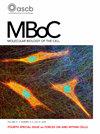FHOD-1 and profilin protect sarcomeres against contraction-induced deformation in C. elegans.
IF 3.1
3区 生物学
Q3 CELL BIOLOGY
引用次数: 0
Abstract
Formin HOmology Domain 2-containing (FHOD) proteins are a subfamily of actin-organizing formins important for striated muscle development in many animals. We showed previously that absence of the sole FHOD protein, FHOD-1, from Caenorhabditis elegans results in thin body wall muscles with misshapen dense bodies that serve as sarcomere Z-lines. We demonstrate here that mutations predicted to specifically disrupt actin polymerization by FHOD-1 similarly disrupt muscle development, and that FHOD-1 cooperates with profilin PFN-3 for dense body morphogenesis, and with profilins PFN-2 and PFN-3 to promote body wall muscle growth. We further demonstrate that dense bodies in worms lacking FHOD-1 or PFN-2/PFN-3 are less stable than in wild type animals, having a higher proportion of dynamic protein, and becoming distorted by prolonged muscle contraction. We also observe accumulation of actin and actin depolymerization factor/cofilin homolog UNC-60B in body wall muscle of these mutants. Such accumulations may indicate targeted disassembly of thin filaments dislodged from unstable dense bodies, possibly accounting for the abnormally slow growth and reduced body wall muscle strength in fhod-1 mutants. Overall, these results implicate FHOD protein-mediated actin assembly in forming stable sarcomere Z-lines, and identify profilin as a new contributor to FHOD activity in striated muscle development.FHOD-1 和 profilin 可保护秀丽隐杆线虫的肌节免受收缩引起的变形。
含甲状腺结构域 2 的甲状腺蛋白(FHOD)是肌动蛋白组织甲状腺蛋白的一个亚家族,对许多动物的横纹肌发育非常重要。我们之前研究发现,秀丽隐杆线虫体内唯一一种 FHOD 蛋白 FHOD-1 的缺失会导致体壁肌肉变薄,并伴有作为肌节 Z 线的畸形致密体。我们在本文中证明,预测会特异性破坏 FHOD-1 肌动蛋白聚合的突变同样会破坏肌肉的发育,而且 FHOD-1 与廓线蛋白 PFN-3 合作促进致密体的形态发生,并与廓线蛋白 PFN-2 和 PFN-3 合作促进体壁肌肉的生长。我们进一步证明,与野生型动物相比,缺乏 FHOD-1 或 PFN-2/PFN-3 的蠕虫致密体的稳定性较差,动态蛋白比例较高,并在肌肉长时间收缩时发生扭曲。我们还在这些突变体的体壁肌肉中观察到肌动蛋白和肌动蛋白解聚因子/纤维蛋白同源物 UNC-60B 的积累。这种积聚可能表明从不稳定性致密体中脱落的细丝被定向分解,这可能是 fhod-1 突变体生长异常缓慢和体壁肌肉强度降低的原因。总之,这些结果表明 FHOD 蛋白介导的肌动蛋白组装形成了稳定的肌节 Z 线,并确定 profilin 是横纹肌发育过程中 FHOD 活性的新贡献者。
本文章由计算机程序翻译,如有差异,请以英文原文为准。
求助全文
约1分钟内获得全文
求助全文
来源期刊

Molecular Biology of the Cell
生物-细胞生物学
CiteScore
6.00
自引率
6.10%
发文量
402
审稿时长
2 months
期刊介绍:
MBoC publishes research articles that present conceptual advances of broad interest and significance within all areas of cell, molecular, and developmental biology. We welcome manuscripts that describe advances with applications across topics including but not limited to: cell growth and division; nuclear and cytoskeletal processes; membrane trafficking and autophagy; organelle biology; quantitative cell biology; physical cell biology and mechanobiology; cell signaling; stem cell biology and development; cancer biology; cellular immunology and microbial pathogenesis; cellular neurobiology; prokaryotic cell biology; and cell biology of disease.
 求助内容:
求助内容: 应助结果提醒方式:
应助结果提醒方式:


